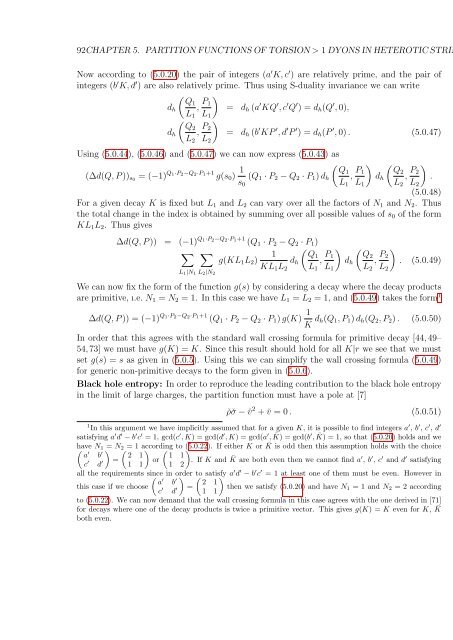PHYS08200604018 Shamik Banerjee - Homi Bhabha National ...
PHYS08200604018 Shamik Banerjee - Homi Bhabha National ...
PHYS08200604018 Shamik Banerjee - Homi Bhabha National ...
You also want an ePaper? Increase the reach of your titles
YUMPU automatically turns print PDFs into web optimized ePapers that Google loves.
92CHAPTER 5. PARTITION FUNCTIONS OF TORSION > 1 DYONS IN HETEROTIC STRIN<br />
Now according to (5.0.20) the pair of integers (a ′ K, c ′ ) are relatively prime, and the pair of<br />
integers (b ′ K, d ′ ) are also relatively prime. Thus using S-duality invariance we can write<br />
(<br />
Q1<br />
d h , P )<br />
1<br />
L 1 L 1<br />
(<br />
Q2<br />
d h , P )<br />
2<br />
L 2 L 2<br />
= d h (a ′ KQ ′ , c ′ Q ′ ) = d h (Q ′ , 0),<br />
= d h (b ′ KP ′ , d ′ P ′ ) = d h (P ′ , 0) . (5.0.47)<br />
Using (5.0.44), (5.0.46) and (5.0.47) we can now express (5.0.43) as<br />
(∆d(Q, P )) s0 = (−1) Q 1·P 2 −Q 2·P 1 +1 g(s 0 ) 1 (<br />
Q1<br />
(Q 1 · P 2 − Q 2 · P 1 ) d h , P ) (<br />
1 Q2<br />
d h , P )<br />
2<br />
.<br />
s 0 L 1 L 1 L 2 L 2<br />
(5.0.48)<br />
For a given decay K is fixed but L 1 and L 2 can vary over all the factors of N 1 and N 2 . Thus<br />
the total change in the index is obtained by summing over all possible values of s 0 of the form<br />
KL 1 L 2 . Thus gives<br />
∆d(Q, P )) = (−1) Q 1·P 2 −Q 2·P 1 +1 (Q 1 · P 2 − Q 2 · P 1 )<br />
∑ ∑<br />
(<br />
1 Q1<br />
g(KL 1 L 2 ) d h , P ) (<br />
1 Q2<br />
d h , P )<br />
2<br />
. (5.0.49)<br />
KL 1 L 2 L 1 L 1 L 2 L 2<br />
L 2 |N 2<br />
L 1 |N 1<br />
We can now fix the form of the function g(s) by considering a decay where the decay products<br />
are primitive, ı.e. N 1 = N 2 = 1. In this case we have L 1 = L 2 = 1, and (5.0.49) takes the form 1<br />
∆d(Q, P )) = (−1) Q 1·P 2 −Q 2·P 1 +1 (Q 1 · P 2 − Q 2 · P 1 ) g(K) 1 K d h(Q 1 , P 1 ) d h (Q 2 , P 2 ) . (5.0.50)<br />
In order that this agrees with the standard wall crossing formula for primitive decay [44, 49–<br />
54,73] we must have g(K) = K. Since this result should hold for all K|r we see that we must<br />
set g(s) = s as given in (5.0.5). Using this we can simplify the wall crossing formula (5.0.49)<br />
for generic non-primitive decays to the form given in (5.0.6).<br />
Black hole entropy: In order to reproduce the leading contribution to the black hole entropy<br />
in the limit of large charges, the partition function must have a pole at [7]<br />
ˇρˇσ − ˇv 2 + ˇv = 0 . (5.0.51)<br />
1 In this argument we have implicitly assumed that for a given K, it is possible to find integers a ′ , b ′ , c ′ , d ′<br />
satisfying a ′ d ′ − b ′ c ′ = 1, gcd(c ′ , K) = gcd(d ′ , K) = gcd(a ′ , ¯K) = gcd(b ′ , ¯K) = 1, so that (5.0.20) holds and we<br />
( have N 1 ) = N 2 ( = 1 according ) ( to (5.0.22). ) If either K or ¯K is odd then this assumption holds with the choice<br />
a<br />
′<br />
b ′ 2 1 1 1<br />
c ′ d ′ = or . If K and<br />
1 1 1 2<br />
¯K are both even then we cannot find a ′ , b ′ , c ′ and d ′ satisfying<br />
all the requirements since ( in order ) ( to satisfy ) a ′ d ′ − b ′ c ′ = 1 at least one of them must be even. However in<br />
a<br />
′<br />
b<br />
this case if we choose<br />
′ 2 1<br />
c ′ d ′ = then we satisfy (5.0.20) and have N<br />
1 1<br />
1 = 1 and N 2 = 2 according<br />
to (5.0.22). We can now demand that the wall crossing formula in this case agrees with the one derived in [71]<br />
for decays where one of the decay products is twice a primitive vector. This gives g(K) = K even for K, ¯K<br />
both even.

















